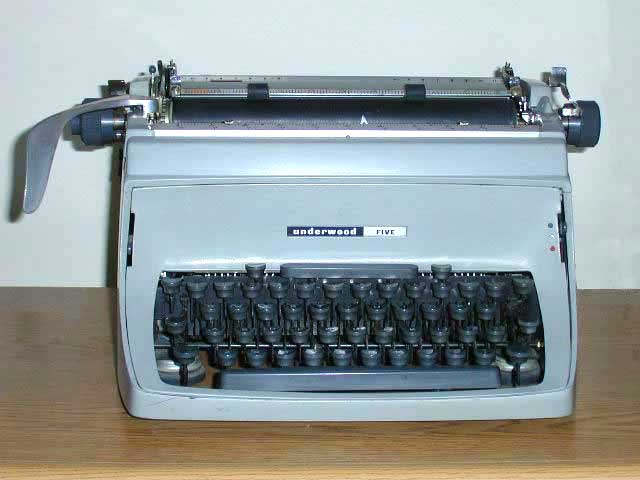|
Flexowriter
The Friden Flexowriter produced by the Friden Calculating Machine Company, was a teleprinter, a heavy-duty electric typewriter capable of being driven not only by a human typing, but also automatically by several methods, including direct attachment to a computer and by use of paper tape. Elements of the design date to the 1920s, and variants of the machine were produced until the early 1970s; the machines found a variety of uses during the evolution of office equipment in the 20th century, including being among the first electric typewriters, computer input and output devices, forerunners of modern word processing, and also having roles in the machine tool and printing industries. History Origins and early history The Flexowriter can trace its roots to some of the earliest electric typewriters. In 1925, the Remington Typewriter Company wanted to expand their offerings to include electric typewriters. Having little expertise or manufacturing ability with electrical appliance ... [...More Info...] [...Related Items...] OR: [Wikipedia] [Google] [Baidu] |
Paper Tape
Five- and eight-hole punched paper tape Paper tape reader on the Harwell computer with a small piece of five-hole tape connected in a circle – creating a physical program loop Punched tape or perforated paper tape is a form of data storage that consists of a long strip of paper in which holes are punched. It developed from and was subsequently used alongside punched cards, differing in that the tape is continuous. Punched cards, and chains of punched cards, were used for control of looms in the 18th century. Use for telegraphy systems started in 1842. Punched tape was used throughout the 19th and for much of the 20th centuries for programmable looms, teleprinter communication, for input to computers of the 1950s and 1960s, and later as a storage medium for minicomputers and CNC machine tools. During the Second World War, high-speed punched tape systems using optical readout methods were used in code breaking systems. Punched tape was used to transmit data for manufacture ... [...More Info...] [...Related Items...] OR: [Wikipedia] [Google] [Baidu] |
Teleprinter
A teleprinter (teletypewriter, teletype or TTY) is an electromechanical device that can be used to send and receive typed messages through various communications channels, in both point-to-point (telecommunications), point-to-point and point-to-multipoint communication, point-to-multipoint configurations. Initially they were used in telegraphy, which developed in the late 1830s and 1840s as the first use of electrical engineering, though teleprinters were not used for telegraphy until 1887 at the earliest. The machines were adapted to provide a user interface to early mainframe computers and minicomputers, sending typed data to the computer and printing the response. Some models could also be used to create punched tape for Computer data storage, data storage (either from typed input or from data received from a remote source) and to read back such tape for local printing or transmission. Teleprinters could use a variety of different communication media. These included a simpl ... [...More Info...] [...Related Items...] OR: [Wikipedia] [Google] [Baidu] |
Electric Typewriter
A typewriter is a mechanical or electromechanical machine for typing characters. Typically, a typewriter has an array of keys, and each one causes a different single character to be produced on paper by striking an inked ribbon selectively against the paper with a type element. At the end of the nineteenth century, the term 'typewriter' was also applied to a ''person'' who used such a device. The first commercial typewriters were introduced in 1874, but did not become common in offices until after the mid-1880s. The typewriter quickly became an indispensable tool for practically all writing other than personal handwritten correspondence. It was widely used by professional writers, in offices, business correspondence in private homes, and by students preparing written assignments. Typewriters were a standard fixture in most offices up to the 1980s. Thereafter, they began to be largely supplanted by personal computers running word processing software. Nevertheless, typewri ... [...More Info...] [...Related Items...] OR: [Wikipedia] [Google] [Baidu] |
Form Letter
A form letter is a letter written from a template, rather than being specially composed for a specific recipient. The most general kind of form letter consists of one or more regions of boilerplate text interspersed with one or more substitution placeholders. Although form letters are generally intended for a wide audience, many form letters include stylistic elements or features intended to appear specifically tailored to the recipient. For example, they might be signed by autopen and use features such as mail merge, which automatically inserts the names of the individual recipients. Uses Form letters are often used as replies from people who get large amounts of correspondence, such as celebrities or politicians. This can lead to controversy if a form letter is used where a more personalised message would have been appropriate, such as when offering condolences. Other form letters are used to notify candidates as part of an application process, such as acceptance or rejection l ... [...More Info...] [...Related Items...] OR: [Wikipedia] [Google] [Baidu] |
Punched Card
A punched card (also punch card or punched-card) is a piece of stiff paper that holds digital data represented by the presence or absence of holes in predefined positions. Punched cards were once common in data processing applications or to directly control automated machinery. Punched cards were widely used through much of the 20th century in the data processing industry, where specialized and increasingly complex unit record machines, organized into semiautomatic data processing systems, used punched cards for data input, output, and storage. The IBM 12-row/80-column punched card format came to dominate the industry. Many early digital computers used punched cards as the primary medium for input of both computer programs and data. While punched cards are now obsolete as a storage medium, as of 2012, some voting machines still used punched cards to record votes. They also had a significant cultural impact. History The idea of control and data storage via punched hol ... [...More Info...] [...Related Items...] OR: [Wikipedia] [Google] [Baidu] |




.jpg)
